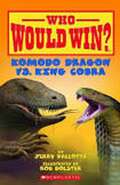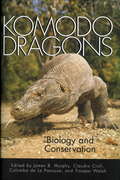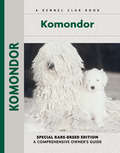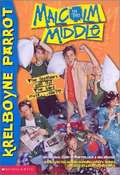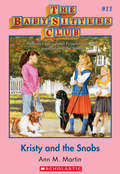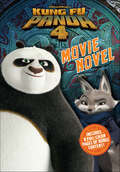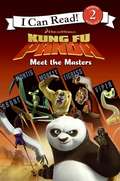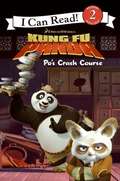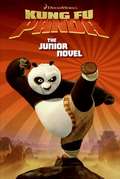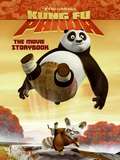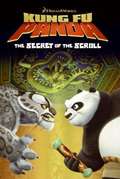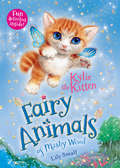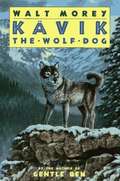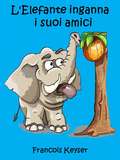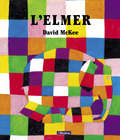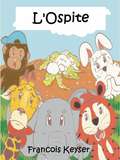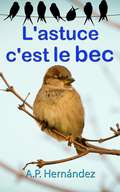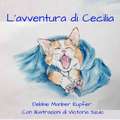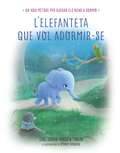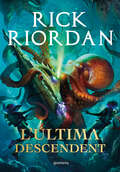- Table View
- List View
Komodo Dragon Vs. King Cobra (Who Would Win? Ser. #6)
by Jerry Pallotta Rob BolsterWhat would happen if a Komodo Dragon and King Cobra met and had a fight? This nonfiction reader compares and contrasts the two species. Students will learn about the animals' anatomies, behaviors, and more. Includes beautiful photos, charts, illustrations, and fascinating facts.
Komodo Dragons
by James B. Murphy Colomba de La Panouse Claudio Ciofi Trooper WalshMore than twenty years have passed since Walter Auffenberg's monumental The Behavioral Ecology of the Komodo Monitor. In the intervening years the populations of Komodo dragons--native only to a handful of islands in southeast Indonesia--have dwindled, sparking intensive conservation efforts. During the last two decades new information about these formidable predators has emerged, and the most important findings are clearly presented here.A memoir from Walter Auffenberg and his son Kurt is followed by the latest information on Komodo dragon biology, ecology, population distribution, and behavior. The second part of the book is dedicated to step-by-step management and conservation techniques, both for wild and captive dragons. This successful model is a useful template for the conservation of other endangered species as well, for, as Kurt and Walter Auffenberg note, "The species may well indeed survive in the wild for generations to come while countless other organisms are lost."
Komodo Dragons (Nature's Children)
by Geoff MillerCan Komodo dragons breathe fire? How many teeth do Komodo dragons have? What do young Komodo dragons look like? Find the answers to these questions, and learn much more about the physical characteristics, behavior, habitat, and lives of Komodo dragons. Other books in this series are available in this library.
Komondor
by Carol Ann Johnson Joy C. LevyAn impressive solid white dog covered by a mass of heavy cords, the Komondor is a courageous flock guardian breed of the Magyar herdsmen, whose ancestry goes back a millennium. The Komondor's principal role was to protect flocks of large animals on the open plains of Hungary: this vigilant giant canine was a solo act, relying only upon his own instincts and decision-making ability to guard his charges. As the appellation "King of Hungarian Sheepdogs" implies, the breed's great size and imposing musculature command respect, and he is loyal, dignified and ever faithful to his kingdom and those within it. The Komondor's skills as a livestock protector combined with his natural intelligence and guardian instincts translate into a superb watchdog for family and home.Author Joy Levy's experience in the breed traces back over three decades; in this Special Rare-Breed Edition she puts forth her unparalleled knowledge and understanding of the Komondor. Along with her late husband Marion J. Levy, Jr., she imported the first Group- and Best in Show-winning Komondor in 1967, bred many top dogs and served as a member of the Middle Atlantic States Komondor Club and the Komondor Club of America.Included here is a complete history of the breed in Europe and the United States as well as an insightful chapter on the breed's characteristics and personality. Additionally, this volume presents many classic and brand-new photographs of the breed and information on the breed standard, puppy acquisition and rearing, everyday care, training, healthcare, showing and much more.
Krelboyne Parrot (Malcolm in the Middle)
by Pam Pollack Meg BelvisoMalcolm's class has a pet parrot named Hitchcock, and each week a student takes him home for the weekend. Malcolm really can't stand the bird. When it's his turn to take Hitchcock home, Malcolm has an accident with a vacuum cleaner, sending Hitchcock to that Great Birdhouse in the Sky. Panicked, Malcolm replaces Hitchcock with a lookalike-- but can he carry off the ruse? Copyright © Libri GmbH. All rights reserved.
Kristy and the Snobs: Kristy and the Snobs (The Baby-Sitters Club #11)
by Ann M. MartinThe hit series is back, to charm and inspire another generation of baby-sitters!After Kristy's mom got married, her family moved to Watson's house in a new neighborhood. But the kids there aren't very friendly--in fact, they're total snobs! They criticize Kristy's clothes, make fun of the Baby-sitters Club. . . and worst of all, they laugh at Louie, Kristy's pet collie, who's going blind. Nobody does that and gets away with it!Kristy's fighting mad, and she's not going to put up with a Snob Attack any longer--and neither is the BSC!The best friends you'll ever have--with classic BSC covers and a letter from Ann M. Martin!
Kung Fu Panda 4 Movie Novel
by Andrews McMeel PublishingPo is the Dragon Warrior, chosen by Master Oogway to wield the Staff of Wisdom. But when Master Shifu makes a shocking announcement—that Po must train his successor and assume the mantle of Spiritual Leader—Po isn&’t sure he&’s ready. He&’s great at kicking butt, but sharing wisdom with the Valley of Peace? Not so much. But when an evil empress named The Chameleon seeks to open the Spirit Realm and steal the knowledge of kung fu masters, Po must find a way to stop her. Otherwise there may not be a world for the next Dragon Warrior to protect! This epic retelling of Kung Fu Panda 4 also contains 8 full-color pages of Po's favorite quotes, like "But first, dumplings." DreamWorks Kung Fu Panda © 2024 DreamWorks Animation LLC. All Rights Reserved.
Kung Fu Panda: Meet the Masters (I Can Read #Level 2)
by Catherine HapkaThe legend of the Dragon Warrior is famous all over the Valley of Peace. Many have dreamed of being chosen. The time has come to name the great warrior. And the Dragon Warrior is ... a clumsy panda?
Kung Fu Panda: Po’s Crash Course (I Can Read! #Level 2)
by Catherine HapkaPo works hard to live up to his title as the Dragon Warrior. But it seems the harder he trains, the more trouble he causes. Can't Po do anything right?
Kung Fu Panda: The Junior Novel
by Susan KormanNo one is more shocked than Po the Panda when he is chosen to become the Dragon Warrior. It is up to Po to defend the Valley of Peace from the evil snow leopard Tai Lung. At first glance, kung fu master Shifu and the Furious Five dismiss Po as a lazy panda who just loves to eat. But when Po is able to turn his love of food into his great strength, he knows he's stumbled upon something special. Join Po as he rises to the occasion and surprises everyone including himself.
Kung Fu Panda: The Movie StoryBook
by Catherine HapkaBy day, Po the panda works in his family's noodle shop ... but by night, Po dreams of kung fu greatness. One day Po is chosen to train alongside his kung fu idols, the Furious Five and Master Shifu.
Kung Fu Panda: The Secret of the Scroll
by J. E. BrightPo is a clumsy, lazy panda. And, oh yeah, he has dreams of becoming a kung fu master instead of working in his family's noodle shop! Po's life gets turned upside down when he is chosen to enter the disciplined world of kung fu. There he meets his idols: Viper, Tigress, Crane, Mantis, Monkey, and kung fu master Shifu. When word gets out that the dangerous snow leopard Tai Lung is headed their way, Po must transform himself into a kung fu master like his idols . . . but will he be able to turn his dreams into reality?
Kuvasz
by Nikki Moustaki Isabelle FrancaisAn ancient breed from the Middle East region, the Kuvasz is hailed as one of Hungary's fearless and courageous flock-guardian dogs. His large, muscular frame is enrobed in a solid white, full, luxuriant coat. This powerful sheepdog cannot be excelled as a guard; he's a self-motivated, thinking dog who lives to protect his family. His innate desire to guard his herd extends to his family, and he's particularly fond and protective of children. Author Nikki Moustaki has compiled a comprehensive and useful guide in this Special Limited Edition dedicated to the Kuvasz, covering the breed's origins, characteristics, the breed standard, showing and more. Guest authors and top breeders, Connie Townsend and Bea Page have provided an extensive look at the breed's history in the United States, highlighting the important dogs and breeders responsible for the breed's progress here. This full-color volume also discusses topics such as selection of a puppy, rearing the puppy, house-training and obedience lessons. Keeping in mind the Kuvasz's unique temperament and high sensitivity to praise and blame, the author instructs owners about the advantages of positive reinforcement in training the breed. As strong-willed and independent as the Kuvasz is, he is still a quick learner given the proper training. General maintenance, including feeding, grooming and exercise, is carefully considered, as is the preventive healthcare of the breed, capably handled by Dr. Lowell Ackerman, covering parasite control, vaccinations, infectious diseases, spay/neuter and much more.
Kylie Kangaroo's Karate Kickers (Animal Antics A to Z)
by Barbara deRubertisKylie Kangaroo is ready to let her kicker fly at Koora's karate club. There's just one tricky trick—will Kylie ever learn to break a brick?
Kylie the Kitten: Fairy Animals of Misty Wood
by Lily SmallEnter an enchanted world of fairy animal friends!It's summertime in Misty Wood, and Kylie the Kitten is heading off to camp. She loves making new friends, but when it comes to swimming in Moonshine Pond, Kylie would rather keep to the shore. She's afraid of water! Can Kylie overcome her fear?
Kävik, the Wolf Dog
by Walt MoreyKävik, a wolf dog, is involved in a plane crash on his way to California, where his new owner lives. Andy Evans finds him and with the help of his family nurses Kävik and saves his life. Soon, Kärik is well and is taken to his rightful owner. After weeks, Kävik escapes from his owner and returns to Andy Evans.
L'Elefante inganna i suoi amici: Una storia che insegna come utilizzare la natura per vivere in armonia con gli animali.
by Francois KeyserL'elefante è affamato, dopo un po' di esplorazione scopre un campo pieno di carote e banane ma c'è un problema... Ci sono api tra lui e le deliziose banane e carote e gli elefanti hanno paura delle api. L'elefante pensa a un modo per prendere le carote e le banane senza essere punto. Arruola l'aiuto dei suoi amici il Coniglio e la Scimmia. Non pensa che vengano punti dalle api ma opportunamente si scorda di informarli riguardo alle api. Quando il piano dell'Elefante va terribilmente storto e i suoi amici realizzano che era a conoscenza delle api decidono di insegnargli una lezione.
L'Elmer (L'Elmer. Primeres lectures #1)
by David MckeeL'Elmer no és com els altres elefants del ramat. Encara que sembli impossible, és un elefant de mil colors: verd, blau, rosa, blanc, groc... Impressionant!, oi? Però a l'Elmer no l'hi fa ni gota de gràcia ser així, més aviat està fart de ser diferent; així que un dia decideix escapar-se del ramat i cercar un remei per poder ser del mateix colors que els altres... Format especial per a tot tipus de dispositius electrònics.
L'Ospite
by Francois KeyserIn questo libro della serie "Gli amici della Giungla" è arrivato un ospite affamato nella giungla. Quando Raff vede l'ospite, sembra che l'ospite abbia già mangiato il suo amico, Giglio il Coniglio. Raff deve trovare i suoi altri amici e avvisarli del pericoloso ospite. Riuscirà a raggiungere i suoi amici prima che l'ospite se li mangi o l'ospite mangerà Raff prima che lui riesca ad avvertire i suoi amici?
L'astuce, c'est le bec
by A. P. HernándezÀ partir de huit ans. Livre ingénieux et amusant pour apprendre du vocabulaire, la conscience de soi et réfléchir sur la valeur des choses matérielles Albert est un moineau très particulier. Tous les jours il passe des heures à lisser et astiquer méticuleusement ses plumes pour être resplandissant. Pour Albert, le plus important est d'avoir un aspect toujours parfait. Sa réputation est telle que tous les oiseaux de toutes les espèces et de tous les coins de la planète assistent à sa sequoya-académie pour prendre des cours de toilettage. Mais quelque chose perturbe sa tranquillité. Un matin, au réveil, Albert découvre qu'il a été victime du terrible vol… Un livre amusant pour les enfants et un recours didactique pour les parents, pédagogues, instituteurs et psychologues pour travailler l'estime de soi et des valeurs comme l'amitié et l'altruisme.
L'aventure de Santo, le cabillaud facteur (L'aventure de Santo, le facteur cabillaud #1)
by Alisa Joel KLe facteur du service postal maritime, Santo, assume une mission spéciale : retrouver l’expédition disparue. Dans ses recherches, en voyageant du Pôle Nord au Pôle Sud, il connaît la diversité de la vie dans l’océan et ses problèmes. Santo parviendra-t-il à sauver la réputation de la poste maritime malgré l’opposition des méchants de la mer ? Car il semble que de la réception de l’expédition dépend l’issue du conflit séculaire entre le Royaume des Manchots et l’Empire des Ours Blancs.
L'avventura di Cecilia
by Debbie Manber Kupfer Ilaria SabatelliCecilia è alla ricerca del suo nuovo umano, ma troverà quello giusto? Ha sentito dire che sono molto difficili da addestrare. Dall’ autrice dei Racconti da O.R.M.A. ed Esmeralda Grunch e il Tulipano Rosso. Con illustrazioni di Victoria Szulc
L'elefanteta que vol adormir-se
by Carl-Johan Forssén EhrlinL'elefanteta que vol adormir-se és l'esperada continuació del bestseller mundial El conillet que vol adormir-se. Un nou mètode per ajudar els nens a dormir, una eina revolucionaria recomanada i elogiada per pares, psicòlegs i terapeutes.. Acompanyeu a l'elefanteta Helena mentre creua un bosc màgic que l'ha de dur al país dels somnis. Pel camí l'Helena i l'infant es trobaran amb personatges fantàstics i viuran aventures relaxants que els ajudaran a calmar-se i a agafar el son ràpidament, tant a la migdiada com a la nit. Els contes de Carl-Johan Forssén Ehrlin s'han traduït a diverses llengües i, gràcies a les seves innovadores tècniques psicològiques, s'han convertit en un mètode revolucionari que ja ha ajudat a milers de pares arreu del món a aconseguir que els seus fills agafin el son. Escrits en llenguatge senzill, aquests contes fan que els nens es relaxin is'adormin fins i tot abans d'acabar la lectura. Ressenyes i opinions de lectors sobre El conillet que vol adormir-se:«El llibre, número u en vendes en diversos països, aconsegueix que els nens s'adormin sense problemes.»ABC «Pares esgotats del món, això és el que estàveu esperant. Si encara no teniu una còpia, heu de comprar-ne una quan abans.»Metro «L'hora d'anar a dormir més tranquil·la que hem tingut en mesos.»Daily Mail «Màgia en un llibre.» «Guauuu... simplement guauuu.» «Un llibre fantàstic.» «Funciona tal com diuennnzzz...» «100% recomanable.»
L'ovelleta que va venir a sopar (L'ovelleta que va venir a sopar #Volumen)
by Steve Smallman Joëlle DreidemyL'ovelleta que va venir a sopar es un conte deliciós ple de valors com l'amistat, la generositat i l'acceptació de les diferencies. A casa del vell llop afamat per sopar sempre hi ha una miserable sopa de verdures!!! Però una nit, truquen a la porta de la petita cabana i es tracta ni més ni menys que d'un pobre xaiet que s'ha perdut. El llop llavors comença a planificar l'estofat suculent amb què s'omplirà l'estómac... Però el be no vol convertir-se en el gran menjar del llop, el que vol és ser el seu amic!Una entranyable història d'amistat.
L'última descendent
by Rick RiordanUN SECRET A LES PROFUNDITATS DE L'OCEÀ UNA BATALLA SOTA EL MAR PER DESCOBRIR LA VERITAT L'Acadèmia Harding-Pencroft no és un institut normal: de les seves classes en surten els millors exploradors submarins i els navegants més prestigiosos del món, que competeixen en condicions extremes dividits entre les cases Dofí, Cefalòpode, Orca i Tauró . Ana Dakkar, una brillant estudiant de primer any, està preparada per a la misteriosa prova de final de curs... fins que una terrible tragèdia canvia el seu destí per sempre. En una cursa contra enemics mortals i trampes submarines, descobrirà que el secret més ben guardat de l'escola està en les profunditats de l'oceà, i només una persona el podrà protegir... L'ÚLTIMA DESCENDENT
